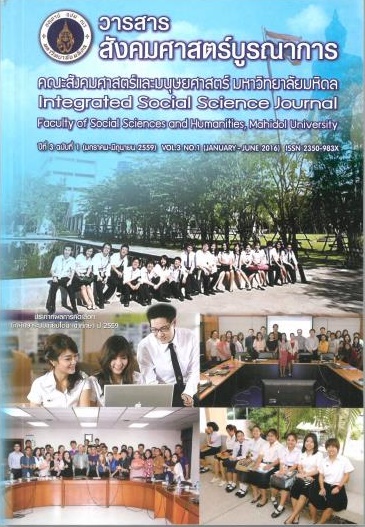Crime Prevention Implementations: A case study of police stations in The Metro Police Bureau, division 9, Royal Thai Police’s
Main Article Content
Abstract
This study aims to study the success of crime prevention policy implementation of the police stationed in the Metropolitan Police Bureau of Nong khaem, Nong Khang Phlu and Lang Song, and to investigate the factors affecting the success of crime prevention policy implementation.
This study is integration approach which integrates between quantitative and qualitative methods and data collecting for 336 cases were gathered from both commissioners and non-commissioners police level in their areas. Research results found that the success of policy implementations all criteria by overview are at high successful level including crime prevention through environmental design, patrol system development, information system development (191 divisions), utilizing technology for crime prevention, social organization (zoning), and enhancing social network to support and participate in crime prevention activities; besides, the crime prevention policy implementation is vary succeed by individual characteristic factors. Therefore, the results are accepted by the first hypothesis.
For factors affected the success of crime prevention policy implementations had a statistical significance, including strategy and process of policy compulsory, communication policy, individual attitude on utilizing policy implementation, independence of policy implementation (policy standard) characteristics of the implementing agencies, political conditions and policy resources respectively. The results are accepted by the second hypothesis and also supported Van Horn and Van Meter’s theory.
Article Details
- Under a CC Attribution-NonCommercial-NoDerivatives 4.0 (CC BY-NC-ND 4.0) license, you can copy, distribute, display, perform, and use any published material (figures, schemes, tables or any extract of a text) for any purpose other than commercially (unless you get permission first).
- Any opinions and views expressed in this publication are the opinions and views of the authors, and are not the views of or endorsed by the journal (including the editor, any member of the editorial team or editorial board, and any guest editors).
- The editor has the right to edit the content of the manuscript to make it suitable for publication.
References
สมบัติ ธำรงธัญวงศ์ (2554). นโยบายสาธารณะ. แนวความคิด การวิเคราะห์และกระบวนการ.กรุงเทพมหานคร : สำนักพิมพ์เสมาธรรม
สำนักงานคณะกรรมการพัฒนาการเศรษฐกิจและสังคมแห่งชาติ. (2554). แผนพัฒนาเศรษฐกิจและสังคมแห่งชาติ ฉบับที่ 11.
สำนักงานตำรวจแห่งชาติ. (2555). คู่มือการบริหารงานและป้องกันปราบปรามอาชญากรรม.กรุงเทพมหานคร : โรงพิมพ์ตำรวจ.
Bailey, S. K., and E.K. Mosher, E. K. (1968) “ ESEA : The Office of Education Administers, Syracuse: Syracuse University.
Barron, Stephen W. (2003) “Self-Control, Social Consequences, and Criminal Behavior: Street Youth and the General Theory of Crime” Journal of Research in Crime and Delinquency November, Vol. 40, no.4 (403-425)
Derthick, M. (1972). New Towns in Town. Washington D.C.: The Urban Institute.
Dolbeare, K. M. and P. E. Hammond. (1971). The School Player Decisions: From Court Policy to Local Practice. Chicago: University of Chicago Press.
Downs, Anthony. (1967). Inside Bureaucracy. Boston: little Brown.
Ellwanger, Stephen J. and Pratt, Travis C. (2014) “Self-Control, Negative Affect, and Young Driver Aggression: An Assessment of Competing Theoretical Claims”
Etzioni, Amitai (1961) A Comparative Analysis of Complex Organizations. New York: free Press.
Kaufman, Herbert. (1971). The Limits of Organization Change. Alabama: University of Alabama Press.
Lab, Stephen P.(1979) Crime Prevention Approaches, Practices and Evaluations. Third Edition. Ohio: Anderson Publishing Co.
Likert, R. (1932). “A Technique for the Measurement of Attitudes” Archives of Psychology; No. 140
Meneses, Rohald A. (2009). “Cross-Cultural Test of Social Learning, Self-Control, Social Bonding and General Theories of Crime And Deviance” Dissertation the Degree of Doctor of Philosophy. Graduate School of the University Of Florida.
Moon, Byongook and Alarid F. (2014) “School Bullying, Low Self-Control, and Opportunity” Journal of Inter Personal Violence June 13.
Murphy, J.T. (1971). “Title I of ESEA: The Politics of Implementation Federal Education” Harvard Educational Review. 41 February.
Peltason, J.W. (1961). Fifty-Eight Lonely Men: Southern Federal Judges and School Desegregation. New York: Harcourt, Brace and World.
Ripley, R.B., G.A. Franklin, W.M. Holmes, and W.M. Moreland. (1973). Structure, Environment, and Policy Actions: Exploring Model of Policy Making. Beverly Hills, California: Sage Publications.
Rourke, F.E. (1969). Bureaucracy, Politics and Public Policy. Boston: Little, Brown.
Neustadt, Richard E. (1960). Presidential Power. New York: John Wiley.
Sampson, Robert J., Morenoff, Jeffrey D. and Raudenbush, Stephen. (2005). “Social Anatomy of Racial and Ethnic Disparities in Violence” American Journal of Public Health. February, Vol. 95, no. 2 (224-232)

